Unit 6 Do you like bananas-第二课时SectionAGrammar Focus-3c习题课件(共25张PPT)
文档属性
| 名称 | Unit 6 Do you like bananas-第二课时SectionAGrammar Focus-3c习题课件(共25张PPT) |  | |
| 格式 | pptx | ||
| 文件大小 | 1.9MB | ||
| 资源类型 | 教案 | ||
| 版本资源 | 人教新目标(Go for it)版 | ||
| 科目 | 英语 | ||
| 更新时间 | 2023-08-20 13:28:16 | ||
图片预览

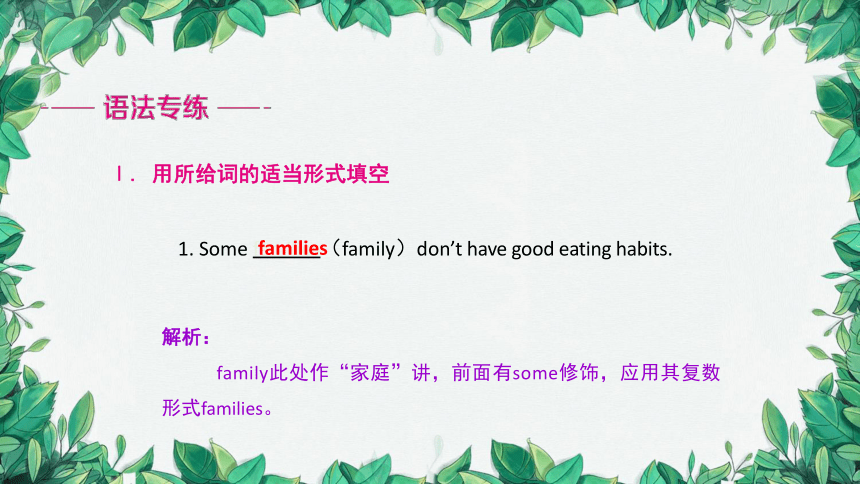
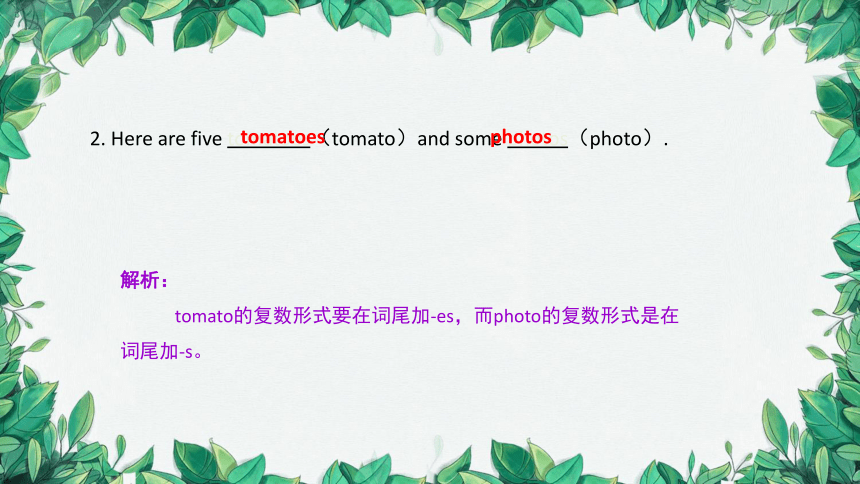
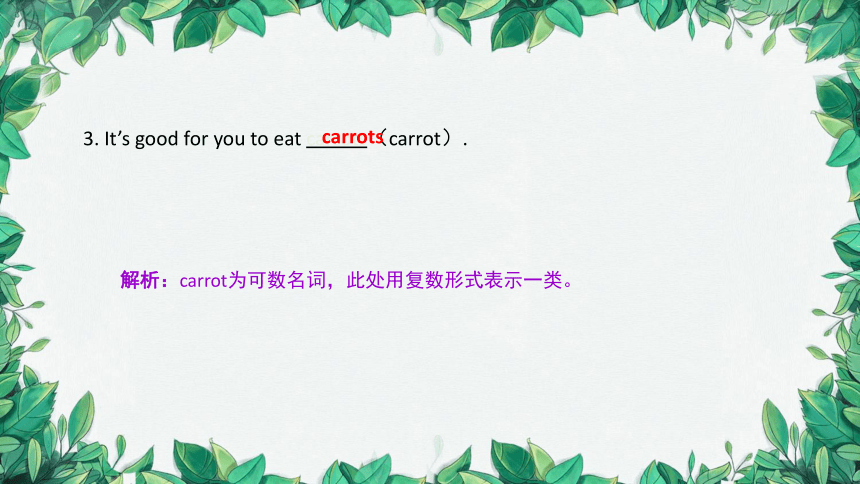
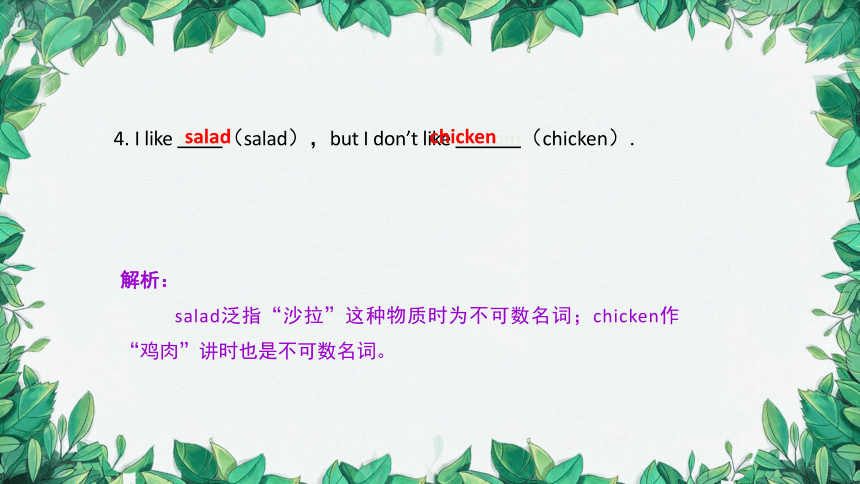



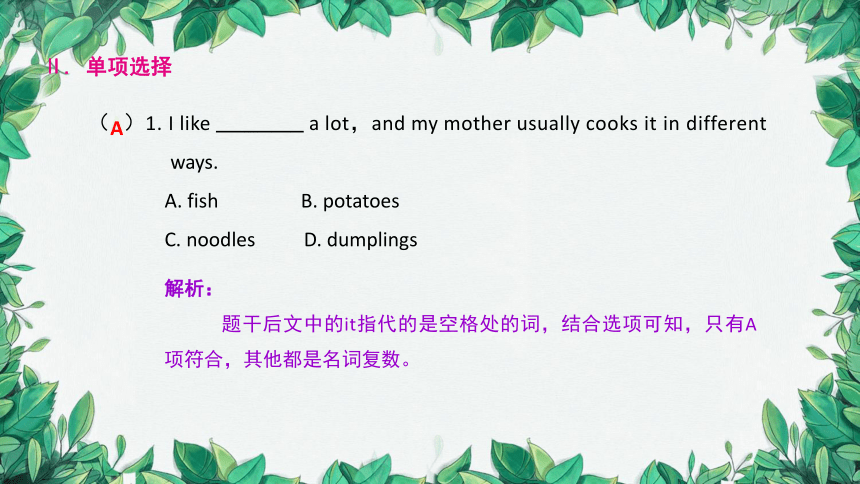
文档简介
(共25张PPT)
第二课时
Section A Grammar Focus-3c
UNIT 6
Ⅰ. 用所给词的适当形式填空
1. Some families(family)don’t have good eating habits.
families
解析:
family此处作“家庭”讲,前面有some修饰,应用其复数形式families。
2. Here are five tomatoes(tomato)and some photos(photo).
tomatoes photos
解析:
tomato的复数形式要在词尾加-es,而photo的复数形式是在词尾加-s。
3. It’s good for you to eat carrots(carrot).
carrots
解析:carrot为可数名词,此处用复数形式表示一类。
4. I like salad(salad),but I don’t like chicken(chicken).
salad chicken
解析:
salad泛指“沙拉”这种物质时为不可数名词;chicken作“鸡肉”讲时也是不可数名词。
5. My sister likes(like)vegetables but she doesn’t like (not like)carrots.
likes doesn’t like
解析:
主语my sister和she都是第三人称单数形式,故前面用like的第三人称单数形式likes,后面要借助助动词does变否定,后面like要用原形。
6. My dad has two eggs(egg)and a glass of milk(milk)every morning.
eggs milk
解析:egg为可数名词,milk为不可数名词。
7. We don’t have any rice(rice).
rice
解析:rice为不可数名词。
Ⅱ. 单项选择
(A)1. I like a lot,and my mother usually cooks it in different ways.
A. fish B. potatoes
C. noodles D. dumplings
解析:
题干后文中的it指代的是空格处的词,结合选项可知,只有A项符合,其他都是名词复数。
A
(C)2. (21-22·石家庄晋州市期末)I buy some for my sisters.
A. ball B. book
C. bread D. carrot
C
解析:
some可修饰可数名词复数或不可数名词, A、B、D三项都是可数名词单数,故排除;bread为不可数名词,故选C。
(B)3. Tony and Tom fruit. But Tony like vegetables.
A. likes;don’t B. like;doesn’t
C. like;don’t D. likes;doesn’t
B
解析:
第一句中主语Tony and Tom表示复数意义,故动词like用原形;第二句中主语Tony为第三人称单数,故句子变否定句要借助助动词does。选B。
(D)4. — does your brother like
—He ice-cream.
A. How;like B. How;likes
C. What;like D. What;likes
D
解析:
答语中主语he为第三人称单数,故谓语动词like要用其第三人称单数形式likes,排除A、C两项;再由答语“他喜欢冰激凌”可知,问句应用what提问,表示“你哥哥喜欢什么?”。故选D。
(D)5. —Do you know the girl in the hat
— .
A. Yes,I am B. Yes,she is
C. Yes,I know D. Yes,I do
D
解析:以Do开头的一般疑问句,其简略答语中也用do,故选D。
Ⅲ. 句型转换
1. Does Cindy like eggs (作肯定回答)
Yes,she does.
2. My cousins like salad.(改为一般疑问句)
Do your cousins like salad
Yes does
Do your like
3. Do they like rice (作否定回答)
No,they don’t.
4. She likes oranges and apples.(对画线部分提问)
What does she like
5. My grandparents like ping-pong.(改为否定句)
My grandparents don’t like ping-pong.
No they don’t
What does
don’t like
词语运用
话题:饮食习惯 难度:★★★ 建议用时:6′
阅读下面短文,在空白处填入一个适当的单词。
Look! This is Bob. That is Jane. They 1. are(be)from different countries. Bob is from Canada. Jane is from the U. S. They 2. like(like)different food. Bob often has bread and milk
3. in the morning. Jane often has 4. an egg and salad. Bob likes to have 5. chicken(chicken)at school. Jane likes 6. fish(fish). Bob likes 7. hamburgers(hamburger). Jane likes noodles. Bob often has an apple in the afternoon,8. but Jane often has two bananas. Bob likes rice and 9. carrots(carrot)in the evening. Jane 10. has(have)dumplings.
1. _______
are
解析:
主语they属于第三人称复数,所以用复数谓语are。
Look! This is Bob. That is Jane. They 1. are(be)from different countries. Bob is from Canada. Jane is from the U. S. They 2. like(like)different food. Bob often has bread and milk
3. in the morning. Jane often has 4. an egg and salad. Bob likes to have 5. chicken(chicken)at school. Jane likes 6. fish(fish). Bob likes 7. hamburgers(hamburger). Jane likes noodles. Bob often has an apple in the afternoon,8. but Jane often has two bananas. Bob likes rice and 9. carrots(carrot)in the evening. Jane 10. has(have)dumplings.
2. _______
like
解析:
主语they属于第三人称复数,所以用动词原形like。
Look! This is Bob. That is Jane. They 1. are(be)from different countries. Bob is from Canada. Jane is from the U. S. They 2. like(like)different food. Bob often has bread and milk
3. in the morning. Jane often has 4. an egg and salad. Bob likes to have 5. chicken(chicken)at school. Jane likes 6. fish(fish). Bob likes 7. hamburgers(hamburger). Jane likes noodles. Bob often has an apple in the afternoon,8. but Jane often has two bananas. Bob likes rice and 9. carrots(carrot)in the evening. Jane 10. has(have)dumplings.
3. _______
in
解析:
in the morning意为“在早上”,属于固定短语。
Look! This is Bob. That is Jane. They 1. are(be)from different countries. Bob is from Canada. Jane is from the U. S. They 2. like(like)different food. Bob often has bread and milk
3. in the morning. Jane often has 4. an egg and salad. Bob likes to have 5. chicken(chicken)at school. Jane likes 6. fish(fish). Bob likes 7. hamburgers(hamburger). Jane likes noodles. Bob often has an apple in the afternoon,8. but Jane often has two bananas. Bob likes rice and 9. carrots(carrot)in the evening. Jane 10. has(have)dumplings.
4. _______
an
解析:
egg是读音以元音音素开头的单词,所以用an。
Look! This is Bob. That is Jane. They 1. are(be)from different countries. Bob is from Canada. Jane is from the U. S. They 2. like(like)different food. Bob often has bread and milk
3. in the morning. Jane often has 4. an egg and salad. Bob likes to have 5. chicken(chicken)at school. Jane likes 6. fish(fish). Bob likes 7. hamburgers(hamburger). Jane likes noodles. Bob often has an apple in the afternoon,8. but Jane often has two bananas. Bob likes rice and 9. carrots(carrot)in the evening. Jane 10. has(have)dumplings.
5. _______
chicken
解析:
chicken属于不可数名词。
Look! This is Bob. That is Jane. They 1. are(be)from different countries. Bob is from Canada. Jane is from the U. S. They 2. like(like)different food. Bob often has bread and milk
3. in the morning. Jane often has 4. an egg and salad. Bob likes to have 5. chicken(chicken)at school. Jane likes 6. fish(fish). Bob likes 7. hamburgers(hamburger). Jane likes noodles. Bob often has an apple in the afternoon,8. but Jane often has two bananas. Bob likes rice and 9. carrots(carrot)in the evening. Jane 10. has(have)dumplings.
6. _______
fish
解析:
fish作“鱼肉”讲时属于不可数名词。
Look! This is Bob. That is Jane. They 1. are(be)from different countries. Bob is from Canada. Jane is from the U. S. They 2. like(like)different food. Bob often has bread and milk
3. in the morning. Jane often has 4. an egg and salad. Bob likes to have 5. chicken(chicken)at school. Jane likes 6. fish(fish). Bob likes 7. hamburgers(hamburger). Jane likes noodles. Bob often has an apple in the afternoon,8. but Jane often has two bananas. Bob likes rice and 9. carrots(carrot)in the evening. Jane 10. has(have)dumplings.
7. _______
hamburgers
解析:
hamburger属于可数名词,所以用复数hamburgers。
Look! This is Bob. That is Jane. They 1. are(be)from different countries. Bob is from Canada. Jane is from the U. S. They 2. like(like)different food. Bob often has bread and milk
3. in the morning. Jane often has 4. an egg and salad. Bob likes to have 5. chicken(chicken)at school. Jane likes 6. fish(fish). Bob likes 7. hamburgers(hamburger). Jane likes noodles. Bob often has an apple in the afternoon,8. but Jane often has two bananas. Bob likes rice and 9. carrots(carrot)in the evening. Jane 10. has(have)dumplings.
8. _______
but
解析:
前后两个分句属于转折关系,所以用but。
Look! This is Bob. That is Jane. They 1. are(be)from different countries. Bob is from Canada. Jane is from the U. S. They 2. like(like)different food. Bob often has bread and milk
3. in the morning. Jane often has 4. an egg and salad. Bob likes to have 5. chicken(chicken)at school. Jane likes 6. fish(fish). Bob likes 7. hamburgers(hamburger). Jane likes noodles. Bob often has an apple in the afternoon,8. but Jane often has two bananas. Bob likes rice and 9. carrots(carrot)in the evening. Jane 10. has(have)dumplings.
9. _______
carrots
解析:
carrot属于可数名词,所以用复数carrots。
Look! This is Bob. That is Jane. They 1. are(be)from different countries. Bob is from Canada. Jane is from the U. S. They 2. like(like)different food. Bob often has bread and milk
3. in the morning. Jane often has 4. an egg and salad. Bob likes to have 5. chicken(chicken)at school. Jane likes 6. fish(fish). Bob likes 7. hamburgers(hamburger). Jane likes noodles. Bob often has an apple in the afternoon,8. but Jane often has two bananas. Bob likes rice and 9. carrots(carrot)in the evening. Jane 10. has(have)dumplings.
10. _______
has
解析:
主语Jane属于第三人称单数,所以动词have 用第三人称单数形式has。
第二课时
Section A Grammar Focus-3c
UNIT 6
Ⅰ. 用所给词的适当形式填空
1. Some families(family)don’t have good eating habits.
families
解析:
family此处作“家庭”讲,前面有some修饰,应用其复数形式families。
2. Here are five tomatoes(tomato)and some photos(photo).
tomatoes photos
解析:
tomato的复数形式要在词尾加-es,而photo的复数形式是在词尾加-s。
3. It’s good for you to eat carrots(carrot).
carrots
解析:carrot为可数名词,此处用复数形式表示一类。
4. I like salad(salad),but I don’t like chicken(chicken).
salad chicken
解析:
salad泛指“沙拉”这种物质时为不可数名词;chicken作“鸡肉”讲时也是不可数名词。
5. My sister likes(like)vegetables but she doesn’t like (not like)carrots.
likes doesn’t like
解析:
主语my sister和she都是第三人称单数形式,故前面用like的第三人称单数形式likes,后面要借助助动词does变否定,后面like要用原形。
6. My dad has two eggs(egg)and a glass of milk(milk)every morning.
eggs milk
解析:egg为可数名词,milk为不可数名词。
7. We don’t have any rice(rice).
rice
解析:rice为不可数名词。
Ⅱ. 单项选择
(A)1. I like a lot,and my mother usually cooks it in different ways.
A. fish B. potatoes
C. noodles D. dumplings
解析:
题干后文中的it指代的是空格处的词,结合选项可知,只有A项符合,其他都是名词复数。
A
(C)2. (21-22·石家庄晋州市期末)I buy some for my sisters.
A. ball B. book
C. bread D. carrot
C
解析:
some可修饰可数名词复数或不可数名词, A、B、D三项都是可数名词单数,故排除;bread为不可数名词,故选C。
(B)3. Tony and Tom fruit. But Tony like vegetables.
A. likes;don’t B. like;doesn’t
C. like;don’t D. likes;doesn’t
B
解析:
第一句中主语Tony and Tom表示复数意义,故动词like用原形;第二句中主语Tony为第三人称单数,故句子变否定句要借助助动词does。选B。
(D)4. — does your brother like
—He ice-cream.
A. How;like B. How;likes
C. What;like D. What;likes
D
解析:
答语中主语he为第三人称单数,故谓语动词like要用其第三人称单数形式likes,排除A、C两项;再由答语“他喜欢冰激凌”可知,问句应用what提问,表示“你哥哥喜欢什么?”。故选D。
(D)5. —Do you know the girl in the hat
— .
A. Yes,I am B. Yes,she is
C. Yes,I know D. Yes,I do
D
解析:以Do开头的一般疑问句,其简略答语中也用do,故选D。
Ⅲ. 句型转换
1. Does Cindy like eggs (作肯定回答)
Yes,she does.
2. My cousins like salad.(改为一般疑问句)
Do your cousins like salad
Yes does
Do your like
3. Do they like rice (作否定回答)
No,they don’t.
4. She likes oranges and apples.(对画线部分提问)
What does she like
5. My grandparents like ping-pong.(改为否定句)
My grandparents don’t like ping-pong.
No they don’t
What does
don’t like
词语运用
话题:饮食习惯 难度:★★★ 建议用时:6′
阅读下面短文,在空白处填入一个适当的单词。
Look! This is Bob. That is Jane. They 1. are(be)from different countries. Bob is from Canada. Jane is from the U. S. They 2. like(like)different food. Bob often has bread and milk
3. in the morning. Jane often has 4. an egg and salad. Bob likes to have 5. chicken(chicken)at school. Jane likes 6. fish(fish). Bob likes 7. hamburgers(hamburger). Jane likes noodles. Bob often has an apple in the afternoon,8. but Jane often has two bananas. Bob likes rice and 9. carrots(carrot)in the evening. Jane 10. has(have)dumplings.
1. _______
are
解析:
主语they属于第三人称复数,所以用复数谓语are。
Look! This is Bob. That is Jane. They 1. are(be)from different countries. Bob is from Canada. Jane is from the U. S. They 2. like(like)different food. Bob often has bread and milk
3. in the morning. Jane often has 4. an egg and salad. Bob likes to have 5. chicken(chicken)at school. Jane likes 6. fish(fish). Bob likes 7. hamburgers(hamburger). Jane likes noodles. Bob often has an apple in the afternoon,8. but Jane often has two bananas. Bob likes rice and 9. carrots(carrot)in the evening. Jane 10. has(have)dumplings.
2. _______
like
解析:
主语they属于第三人称复数,所以用动词原形like。
Look! This is Bob. That is Jane. They 1. are(be)from different countries. Bob is from Canada. Jane is from the U. S. They 2. like(like)different food. Bob often has bread and milk
3. in the morning. Jane often has 4. an egg and salad. Bob likes to have 5. chicken(chicken)at school. Jane likes 6. fish(fish). Bob likes 7. hamburgers(hamburger). Jane likes noodles. Bob often has an apple in the afternoon,8. but Jane often has two bananas. Bob likes rice and 9. carrots(carrot)in the evening. Jane 10. has(have)dumplings.
3. _______
in
解析:
in the morning意为“在早上”,属于固定短语。
Look! This is Bob. That is Jane. They 1. are(be)from different countries. Bob is from Canada. Jane is from the U. S. They 2. like(like)different food. Bob often has bread and milk
3. in the morning. Jane often has 4. an egg and salad. Bob likes to have 5. chicken(chicken)at school. Jane likes 6. fish(fish). Bob likes 7. hamburgers(hamburger). Jane likes noodles. Bob often has an apple in the afternoon,8. but Jane often has two bananas. Bob likes rice and 9. carrots(carrot)in the evening. Jane 10. has(have)dumplings.
4. _______
an
解析:
egg是读音以元音音素开头的单词,所以用an。
Look! This is Bob. That is Jane. They 1. are(be)from different countries. Bob is from Canada. Jane is from the U. S. They 2. like(like)different food. Bob often has bread and milk
3. in the morning. Jane often has 4. an egg and salad. Bob likes to have 5. chicken(chicken)at school. Jane likes 6. fish(fish). Bob likes 7. hamburgers(hamburger). Jane likes noodles. Bob often has an apple in the afternoon,8. but Jane often has two bananas. Bob likes rice and 9. carrots(carrot)in the evening. Jane 10. has(have)dumplings.
5. _______
chicken
解析:
chicken属于不可数名词。
Look! This is Bob. That is Jane. They 1. are(be)from different countries. Bob is from Canada. Jane is from the U. S. They 2. like(like)different food. Bob often has bread and milk
3. in the morning. Jane often has 4. an egg and salad. Bob likes to have 5. chicken(chicken)at school. Jane likes 6. fish(fish). Bob likes 7. hamburgers(hamburger). Jane likes noodles. Bob often has an apple in the afternoon,8. but Jane often has two bananas. Bob likes rice and 9. carrots(carrot)in the evening. Jane 10. has(have)dumplings.
6. _______
fish
解析:
fish作“鱼肉”讲时属于不可数名词。
Look! This is Bob. That is Jane. They 1. are(be)from different countries. Bob is from Canada. Jane is from the U. S. They 2. like(like)different food. Bob often has bread and milk
3. in the morning. Jane often has 4. an egg and salad. Bob likes to have 5. chicken(chicken)at school. Jane likes 6. fish(fish). Bob likes 7. hamburgers(hamburger). Jane likes noodles. Bob often has an apple in the afternoon,8. but Jane often has two bananas. Bob likes rice and 9. carrots(carrot)in the evening. Jane 10. has(have)dumplings.
7. _______
hamburgers
解析:
hamburger属于可数名词,所以用复数hamburgers。
Look! This is Bob. That is Jane. They 1. are(be)from different countries. Bob is from Canada. Jane is from the U. S. They 2. like(like)different food. Bob often has bread and milk
3. in the morning. Jane often has 4. an egg and salad. Bob likes to have 5. chicken(chicken)at school. Jane likes 6. fish(fish). Bob likes 7. hamburgers(hamburger). Jane likes noodles. Bob often has an apple in the afternoon,8. but Jane often has two bananas. Bob likes rice and 9. carrots(carrot)in the evening. Jane 10. has(have)dumplings.
8. _______
but
解析:
前后两个分句属于转折关系,所以用but。
Look! This is Bob. That is Jane. They 1. are(be)from different countries. Bob is from Canada. Jane is from the U. S. They 2. like(like)different food. Bob often has bread and milk
3. in the morning. Jane often has 4. an egg and salad. Bob likes to have 5. chicken(chicken)at school. Jane likes 6. fish(fish). Bob likes 7. hamburgers(hamburger). Jane likes noodles. Bob often has an apple in the afternoon,8. but Jane often has two bananas. Bob likes rice and 9. carrots(carrot)in the evening. Jane 10. has(have)dumplings.
9. _______
carrots
解析:
carrot属于可数名词,所以用复数carrots。
Look! This is Bob. That is Jane. They 1. are(be)from different countries. Bob is from Canada. Jane is from the U. S. They 2. like(like)different food. Bob often has bread and milk
3. in the morning. Jane often has 4. an egg and salad. Bob likes to have 5. chicken(chicken)at school. Jane likes 6. fish(fish). Bob likes 7. hamburgers(hamburger). Jane likes noodles. Bob often has an apple in the afternoon,8. but Jane often has two bananas. Bob likes rice and 9. carrots(carrot)in the evening. Jane 10. has(have)dumplings.
10. _______
has
解析:
主语Jane属于第三人称单数,所以动词have 用第三人称单数形式has。
同课章节目录
- starters 预备篇(2012秋审查)
- Unit 1 Good morning !
- Unit 2 What’s this in English?
- Unit 3 What color is it ?
- Unit 1 My name's Gina.
- Section A
- Section B
- Unit 2 This is my sister.
- Section A
- Section B
- Unit 3 Is this your pencil?
- Section A
- Section B
- Unit 4 Where's my schoolbag?
- Section A
- Section B
- Unit 5 Do you have a soccer ball?
- Section A
- Section B
- Unit 6 Do you like bananas?
- Section A
- Section B
- Unit 7 How much are these socks?
- Section A
- Section B
- Unit 8 When is your birthday?
- Section A
- Section B
- Unit 9 My favorite subject is science.
- Section A
- Section B
